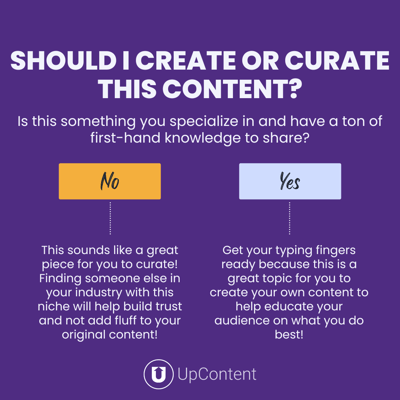What Kind of Content Should You Curate?
.png?width=2240&height=1260&name=63570430fdaa3d86f9893c07_Blog%20Banner%20for%20Website%20Content%20(7).png)
Did you know that 82% of companies actively implement a content marketing strategy?
And if you’re reading this article, you’re likely one of them.
The world is your oyster when it comes to content marketing; there’s so much you can do!
But many people limit themselves by assuming content marketing is synonymous with content creation.
My friend, that is so far from the truth!
We have been inundated with content creation strategies for so long that’s how we approach marketing now instead of taking advantage of a better, more effective approach: the content mix.

Studies have shown that a great place to start with content mixing is 60% curated and 40% created.
This has proven to increase engagement and CTR, leading to more sales.
But how do you know what kind of content you should be mixing into your strategy?
An easy way to begin content mixing is through content curation!
Content curation is finding the content you didn’t create and sharing it with your readers because you know it would bring them value and adds context to what you are already creating.
At UpContent, we have helped hundreds of companies implement a content mix into their overall marketing and sales strategies, increasing engagement, trust, and expertise for their customers and internal staff!
Content should provide value, and we specialize in finding the best content for YOU so you can intentionally curate rather than haphazardly share an article you came across in a Google search.
In this article, we’re going to talk about different content you can curate, the problem with curating visual content, and the kinds of content you should be curating.
Technically, content curation is the sharing of third-party content.
However, left just at that short, and we think incomplete, definition you could, in theory, share any content you come across as long as you do so legally and ethically.
But we believe content curation should be more strategic than just sharing anything you see and like.
The content you’re sharing should be relevant and valuable but should also be delivered in a way that builds trust between you and your audience.
Follow me through this scenario.
You’re on LinkedIn, and a company has shared this really amazing article containing an infographic that just made five different lightbulbs go off in your head.
You get to the bottom of the article only to find out that they curated that infographic from another company, and there’s a little drop in your stomach.
“Wait, if they didn’t come up with that, then what actual value did this company give me? “
Cue finding yourself back on Google trying to find the link to where the graphic was originally used to understand the original context around it.
Instead of building your thought leadership and trust, you stimulated another research exercise and may have lost them down a reverse image search rabbit hole.
When sharing visual content, we think it’s tough to curate and build trust with your audience while creating a pleasing experience for your audience and adhering to the copyright of the original creator.
When it comes to videos, graphics, and other visual content, creating is the most effective when they live in a content creation or user-generated space rather than curating.
There can always be exceptions to that rule, but we recommend not sharing curated visual content if possible.
So if you shouldn’t curate visual content, what can you curate?
Written content!
According to HubSpot, blogs were the second most popular form of content marketing in 2021.
“Content curation not only alleviates the pressure of having to devote valuable time to creating original content, but it also adds credibility and third-party validations to your efforts,” Jason Miller, Senior Content Manager at LinkedIn, says.
Curating written content such as blogs and news articles is a great way to expand on your thoughts and ideas you may not specialize in while showing you value others’ opinions.
It’s also easier to attribute and link back to the original piece of written content.
It’s clear to your reader that this piece is not by you, but you are sharing someone else’s thoughts because you think it’s helpful and worth taking time to read.
We believe content curation deserves the same strategic weight as content creation does but that it doesn’t have to take as much effort or time.
A content creator’s time is usually limited, so knowing what content you should be focused on creating can help you build your content mix!
While nuances certainly exist between what to create and what to curate, there is a single question that can be used to guide your decision. “Is the topic to be discussed something you specialize in and have a unique knowledge of?”

Content creation is always best for topics and areas you specialize in that you have a ton of knowledge on.
For example, maybe you work for a roofing company, so writing articles and creating videos around roofing makes sense.
Content curation is best for building your thought leadership and making yourself a resource on related industry topics.
So, as a roofing company, you wouldn’t write an article about how to remodel a bathroom unless you offered that service and had expertise in it, right?
Instead, you could share an article created by a local construction company focusing on bathroom remodels.
You could link to their piece, mention them on social media, and build rapport with your readers and that company.
You can then add your thoughts or perspective as to why this article is great for your customers to read, keeping you front of mind, and building yourself as a resource not just for roofs but anything they might need help with in their home.
Employing a curation strategy also puts you in a positive light amongst those you curate from - often enticing them to return the favor in presenting your unique knowledge to their audience in pieces you have created.
Nobody likes spending countless hours on Google to try and find information when they could go somewhere and find credible information a lot faster.
While search engines have become more innovative and sophisticated, it’s still hard to know who to trust if 1.2 million results pop up in less than half a second.
Creating content establishes that you are an expert when they need you, and curating content allows you to be who they remember and the go-to source when they need information related to your industry!
Next Steps to Curate the Best Kind of Content
Content marketing is only as successful as the value of the content you bring to your audience.
There are certain kinds of content that you should be creating, but content creation shouldn’t be the only part of your content marketing strategy.
If you’re interested in learning more about how content curation can help your content marketing strategy, feel free to talk to one of our Content Curation Experts today.
Or, if you’d rather read more about content curation, check out some of these articles!
Created Content vs. Curated Content
Why Your Social Selling Strategy Isn’t Working, and How You Can Fix It



